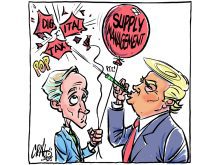The Canadian dairy industry hasn’t done itself any favours in the aftermath of a report that claims farmers have dumped a large amount of milk in the last 12 years.
The study, written by three academics including Sylvain Charlebois from Dalhousie University, angered dairy producers but produced little meaningful explanation from the industry.
The study’s allegations are shocking and certainly worthy of the industry’s attention.
Read Also

High prices see cow-calf producers rushing to incorporate
Farm accountants are reporting a steady stream of cow-calf producers rushing to get their operations incorporated ahead of selling their calves this fall.
It claims that Canadian dairy farmers have discarded 6.8 billion litres of milk since 2012, which could have supplied annual dairy consumption for 4.2 million Canadians.
The academics also found that the waste could be worth as much as $14.9 billion.
Farmers were outraged by the allegations, which they felt were flat-out wrong, but the response from their organizations was tepid, to say the least.
When approached to talk about the report for the first story the Western Producer published, Dairy Farmers of Canada responded with this short statement:
“The authors of the study acknowledge that much of their conclusions are drawn from ‘estimates’ rather than a robust data set. These data assumptions and calculations would need to be validated independently.
“Milk disposal is not a unique issue to Canada. Although supply management is aligned to the needs of the domestic market, when there is a surplus of milk, often it is linked to supply chain issues.
“Milk is disposed only as a last resort after exploring all other alternatives. This is done in accordance with regulations and the costs are borne by the dairy farmers.”
A deeper discussion of milk dumping is important. We at the Producer wanted to speak with dairy farmers and their representatives about why milk is dumped and what they think is a more accurate figure for the amount discarded.
While the Canadian Dairy Commission provided a more comprehensive response for a follow-up article, our attempts to put a human face on the issue, by discussing it with dairy farmers, continued to fall on deaf ears.
Numerous attempts to talk with dairy producers and officials from provincial dairy associations came up empty. Yet a personalized response would likely have eased Canadians’ concerns about the allegations.
The dairy industry has been successful over the years at creating a positive story told through advertising and other promotional activities.
Maybe it felt engaging with reporters in a frank discussion about milk dumping would jeopardize those efforts. Maybe it hopes the issue will blow over if they don’t engage.
If this is the case, it’s a dangerous strategy, considering the immense pressure already exerted on supply management.
Unfortunately, this is not an isolated case in Canada. From government officials to commodity organizations, the industry tends to be stingy with information.
It has become nearly impossible to shake information out of governments, particularly at the federal level.
A request for information to a government department will take days to bear fruit, and when it does, it is almost always an emailed statement that often doesn’t answer the original question.
Some commodity groups are almost as bad, which is a sharp contrast to their counterparts in the United States, who eagerly provide informative interviews.
This cultural divide over information is puzzling and distressing.
Many consumers question how and why farmers do what they do, and producers are encouraged to respond by telling their stories.
This is great advice, but it shouldn’t be limited to happy stories on social media.
Information is key to bridging the divide between farmers and non-farmers, and that must start by being more willing to answer questions.














